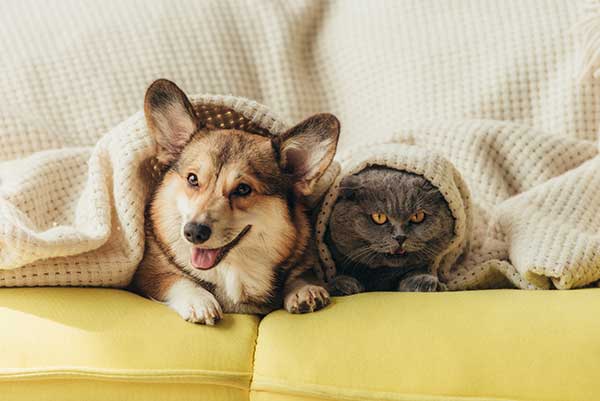On YouTube, you’ll see that dogs and cats are fabulous friends. A parrot perched on a dog head is great entertainment. It’s a very amazing and joyful experience. However, it might take months for your new dog and other pets to grow acclimated to each other.
Sometimes a new dog will get along with the rest of your animals straight immediately, but this is not always the case. Ultimately, you can’t control how your pets interact with one other. As any professional matchmaker knows, you may boost your chances of success with a well-planned introduction.
Take advantage of these tips when you first bring your new puppy home to ensure a smooth transition for everyone involved.
1. Begin Introduction in a Neutral Space
When introducing dogs, you last want an immediate territorial battle. Instead of bringing your new dog into your house, let them meet in a neutral environment where your current dog will not feel threatened.
Go for a stroll with the dogs in the neighborhood or a nearby park with a friend or family member to assist you in holding the leashes. At first, they may be reluctant to engage in conversation, but that’s normal. The sooner they feel at ease, the sooner they’ll open up and participate.
Let them get to know one other for a few seconds before separating them and giving them some privacy. Let them play for longer if they’re both demonstrating good body language, and then bring them back home.
2. Observe the Body Language
Having a feel of how the meeting is going can be helpful when introducing your new pup to your existing dog (or another pet). Unfortunately, dogs are not able to speak. Even though they can’t talk, they can tell you a lot with their body language.
You may learn a great deal about how your dog feels by paying attention to their body language.
Congratulations if you can tell that your dog is comfortable! The introduction may go on as long as it’s relevant.
To prevent things from getting out of hand, stay looking for symptoms of aggressiveness or fear.
3. While Handling Kittens and Other Tiny Animals, Go Cautiously
How can you get a dog and a cat to meet? The first step is to keep them apart. A baby gate or a screen may keep them apart until they acclimate to one other’s scent.
Your dog should be on a leash when you meet them face-to-face, and your rabbit should be able to escape quickly to a suitable hideout. You don’t want them to meet if your dog is on high alert or extremely interested in the cat.
It’s best to hold off on the introduction until your dog has calmed down and is no longer barking or clawing at the entrance. In the same way, it works for other tiny animals as well.
Always keep your dog on a leash during face-to-face introductions with another animal, even if the other animal is friendly. For example, German shepherds are strong, protective, and prey-driven. Because of these characteristics, they are not the best dogs to have as a pet if you have a cat.

4. Be Cautious with Food, Toys, and Any Other Resources
As a preventative measure, ensure that each pet has its own food, drink, and bedding. For the time being, feed them in separate rooms with no access to their favorite toys or other mementos.
When it comes to food and chews, be cautious for the first three months. About that long, it takes a new canine to feel at home in its new environment. Other pets are more likely to protect their belongings if they haven’t yet settled in.
5. Make Sure Each Pet Has a Place Where They Can Feel Secure and Comfortable
An area where pets may relax and feel comfortable is a must for every pet owner. A crate or baby gates may be used to provide a safe haven for your new pooch to unwind in (and give your other dog or pet a break from their new roommate).
Cats must have a safe place to go in case they get into trouble. When your pet rabbits are terrified, they need a hideout they can go to feel protected.
6. Make Time for Playtime Breaks
Even if the two of them are having a fantastic time, many dogs don’t know when to say “when.”
Nonstop play, however, may lead to improper behavior if dogs get too exhausted as a result of it. Taking a break from one another enables your canines to de-stress and refocus.
Set aside separate rooms for each pet, or use a dog fence to keep them apart if necessary. Even dogs need time away from their roommates every now and again, just like everyone else.
7. Monitor Interactions
Watch how your dog and the other animals interact as they grow to know one other. Intervene if you see any snarling or angry body language and praise them for their good behavior.
Try to divert your dog’s interest and then separate the two of you for a while. When it comes to the first three weeks, avoid leaving pets together. Keep an eye on them whenever they’re with one another. In addition, please don’t leave them alone in the home together unless you’re sure they get along.
Don’t become irritated when the introduction isn’t going as planned and choose to beat or yell at him. This might lead to your dog being aggressive and defiant, which is the last thing you want in a house dog.

Final Thoughts
Even though you and everyone else in your family would prefer that your present pets wear party hats when you bring your new puppy home, you must understand that this is not always the reality.
Young puppies, in particular, may be a bother to other animals, and the attention he receives from other pets may make them feel uncomfortable. It takes time to become used to one another (up to six months is not uncommon).
Thus, patience is a virtue when effectively adjusting to a new canine in your household. One of pet owners’ most common mistakes is attempting to speed the process.
Helping animals learn to live in harmony is a long process. It may move fast at times and take a long time at other times. But don’t skip any of the stages. You’ll reap the benefits of your patience in the end.
Checkout Our Favorite Dog Products
1. BEST PUPPY TOY
We Like: Snuggle Behavior Toy with Heart Beat & Heat Pack – Ideal toy for new puppies.
2. BEST DOG TRAINING PROGRAM
We Like: Doggy Dan The Online Dog Trainer – Stop any dog problem and raise the perfect puppy with The Online Dog Trainer.
3. BEST DOG PUZZLE TOY
We Like: Outward Hound Interactive Puzzle Toy – Every dog loves chasing squirrels at the park. The Outward Hound Hide-a-Squirrel Puzzle Toy gives your dog the same feeling as though he was outdoors chasing live squirrels.
4. Best Bone Broth for Dogs
We Like: (Solid Gold – Human Grade Bone Broth for Dogs) – Simmered Beef Bone Broth With Turmeric Provides A Nutrient-Dense And Flavorful Addition To Your Dog’s Meal + Rich In Natural Collagen From Beef Bones.
5. Best Multivitamin for Dogs
We Like: PetHonesty 10-For-1 Multivitamin – 10 Benefits in 1 Daily Treat – These Multivitamin Snacks combine a well-rounded blend of the most essential vitamins and supplements including glucosamine, probiotics, vitamins and omegas, for dogs’ overall daily health.


